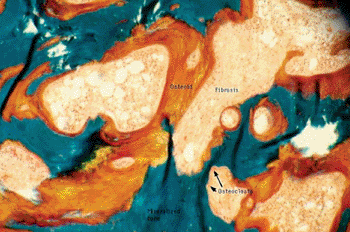Vitamin Testing in Babies Uses Tears
By LabMedica International staff writers
Posted on 02 Jan 2014
Identifying vitamin deficiencies in babies involves drawing blood, a disheartening experience for all involved, but a painless alternative has been developed. Posted on 02 Jan 2014
Instead of using blood plasma, chemical engineers, are developing a simple analysis tool for tears using a simple absorbent strip placed against the lower eyelid to collect all the fluid needed, and then analyze it.

Image: Histology of a bone biopsy from a patient with vitamin D deficiency and osteomalacia (Photo courtesy of the University of Washington).
Scientists at the Michigan Technological University (Houghton, MI, USA) carried a small clinical trial with 45 infants ranging from newborn to 12 months of age. During the initial work, the team has identified all vitamins except one in infant tears using conventional laboratory techniques. They are comparing those measurements with vitamin levels in the toddlers’ blood plasma to see if they correlate and the initial results are promising.
The team aims to measure levels of vitamins A, C, D, E, and K, plus all the B vitamins, using tears and a hand-held diagnostic tool called a lab-on-a-chip. Once vitamin levels in small volumes of tears are correlated to blood plasma tests, a lab-on-a-chip detection device will allow widespread and low-cost clinical assessment of children.
Adrienne Minerick PhD, an associate professor of chemical engineering at the University, said, “Ideally, infants would never experience nutritional deficiencies, but there are regions of the world where up to 40% of children are malnourished. By the time symptoms of deficiencies are recognizable, damage has already occurred that can impact child development. Our easy, painless, and inexpensive method will be able to identify deficiencies much early than symptoms diagnosis, before lasting damage occurs.”
Related Links:
Michigan Technological University














